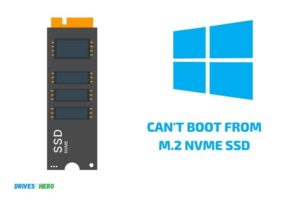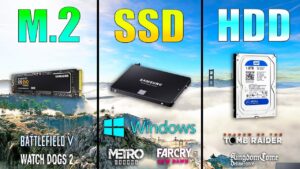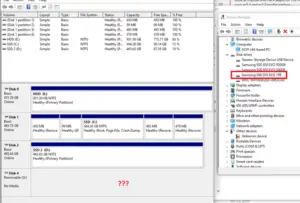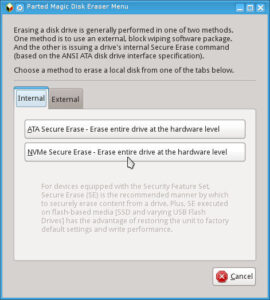Can’t Format Nvme Ssd? Comprehensive Guide!
If you are unable to format NVMe SSD, it may be due to certain issues such as a faulty drive, incorrect file system, the drive being write-protected, or due to errors in Windows Disk Management.
However, you can attempt solutions like using a different formatting tool, checking the SSD’s health, or updating your SSD’s firmware.
NVMe (Non-Volatile Memory Express) SSD (Solid State Drive) is a type of storage device that uses high-speed PCIe lanes to deliver fast data transfer speeds.
However, like every storage device, there might be instances where users can’t format their NVMe SSD. This could be due to a variety of reasons ranging from hardware issues to software problems.
If you’re unable to format your NVMe SSD, don’t panic. First, ascertain the health of the SSD, as a faulty drive may prevent formatting.
If the drive is healthy, try a different formatting tool rather than Windows Disk Management as the latter can sometimes fail.
Always make sure your SSD’s firmware is up-to-date to avoid any compatibility or performance issues. Finally, check for write-protection which can be removed via certain commands or software.
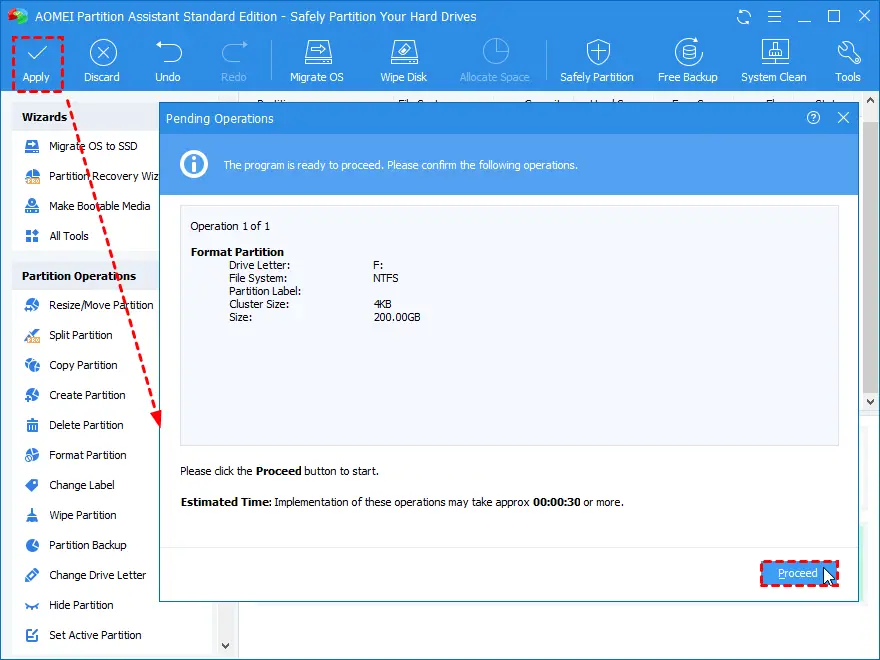
Key Takeaway
Five Facts About Troubleshooting NVMe SSD Formatting Issues
Causes Of Nvme Ssd Formatting Issues
Nvme SSD formatting issues can occur due to various reasons, such as incompatible drivers, file system errors, or firmware issues.
These issues can prevent users from formatting their Nvme SSDs, but troubleshooting and addressing the underlying causes can help resolve the problem.
Incompatible File System
- NTFS vs FAT32: Differences and limitations:
- NTFS: This file system offers advanced features such as file compression, encryption, and the ability to handle large files. However, it is not well-suited for certain devices like older gaming consoles and operating systems.
- FAT32: This file system is compatible with a wide range of devices and operating systems, but it has limitations when it comes to file size and maximum storage capacity.
Understanding the limitations of exFAT:
- ExFAT is a file system designed to overcome the limitations of FAT32, allowing for larger file sizes and storage capacities. However, it may not be supported by all devices and operating systems.
Disk Partitioning Errors
- MBR vs GPT: An overview of partition styles:
- MBR (Master Boot Record): This partitioning system is widely supported by older devices and operating systems. However, it has limitations when it comes to the number of partitions and maximum storage capacity it can handle.
- GPT (GUID Partition Table): This newer partitioning system supports larger storage capacities and a virtually unlimited number of partitions. It is recommended for modern devices and operating systems.
Common partitioning errors causing formatting issues:
- Incorrect partitioning scheme selection during formatting.
- Presence of conflicting partition tables.
- Software errors during partition creation or modification.
Firmware Compatibility
Importance of firmware updates for SSDs:
- Firmware updates often include performance improvements, bug fixes, and enhanced compatibility with newer devices and operating systems. Keeping your SSD firmware up to date is crucial to avoid compatibility issues.
Firmware compatibility issues with Nvme SSDs:
- Outdated firmware can lead to formatting issues or inability to access the SSD.
- Incompatibility between the SSD firmware and the system’s firmware can cause formatting problems.
By understanding these causes of NVME SSD formatting issues, you can troubleshoot and resolve any problems you encounter.
Remember to always double-check the compatibility of file systems, and partitioning schemes, and keep your SSD firmware up to date to ensure smooth formatting processes.
Troubleshooting Nvme Ssd Formatting Problems
Discover troubleshooting tips to overcome formatting problems and successfully format your Nvme SSD hassle-free.
Check Disk Management
To begin troubleshooting your Nvme SSD formatting problems, it’s important to first check Disk Management.
Here’s how you can access the Disk Management utility:
- Press the Windows key + R simultaneously to open the Run dialog box.
- Type “diskmgmt.msc” and hit Enter to launch Disk Management.
Once you have opened Disk Management, follow the steps below to identify and resolve any formatting issues:
Identifying The Nvme Ssd In Disk Management
When you access Disk Management, you might not immediately see your Nvme SSD.
To identify it, follow these steps:
- Look for a disk with unallocated space or a disk labeled “Unknown.”
- Make a note of the corresponding disk number for your Nvme SSD.
Resolving Drive Conflicts And Assigning Drive Letters
Sometimes, conflicts with other drives or missing drive letters can prevent Nvme SSD formatting.
Here’s how you can resolve these issues:
- Right-click on the Nvme SSD and select “Properties.”
- Go to the “Volumes” tab and click on “Populate” to assign a drive letter automatically.
If the above steps don’t resolve the issue, you might need to manually assign a drive letter.
Here’s how:
- Right-click on the Nvme SSD again and select “Change Drive Letter and Paths.”
- Click on “Add” and choose a letter from the drop-down menu to assign to your Nvme SSD.
Format Nvme Ssd Using Command Prompt
If the Disk Management utility doesn’t solve your formatting problem, you can use the Command Prompt.
Here’s a step-by-step guide:
- Open Command Prompt as administrator.
- Type “diskpart” and hit Enter to open the DiskPart utility.
- Enter “list disk” and hit Enter to display a list of all the disks connected to your system.
- Identify your Nvme SSD based on its size and note its corresponding disk number.
- Enter “select disk [disk number]” (replace [disk number] with the actual disk number) and hit Enter.
- Finally, type “clean” and press Enter to erase all data on the disk, preparing it for formatting.
Tips For Resolving Common Issues During Formatting
While formatting your Nvme SSD, you might encounter some common issues.
Here are a few tips to help you overcome them:
- Ensure that your Nvme SSD is properly connected to your system.
- Check for any firmware or driver updates for your Nvme SSD.
- Disable any antivirus software temporarily, as it might interfere with the formatting process.
- Double-check that you have administrative privileges to format the Nvme SSD.
Utilizing Third-Party Formatting Tools
In addition to the built-in Windows utilities, there are popular third-party formatting tools you can use for Nvme SSD formatting. These tools offer additional features and benefits, such as enhanced performance or advanced formatting options.
Some notable third-party formatting tools include:
- Tool 1: This tool provides a user-friendly interface and supports various formatting options.
- Tool 2: With this tool, you can securely erase data from your Nvme SSD to protect your privacy.
- Tool 3: This tool offers advanced optimization features to improve your Nvme SSD’s performance.
Using these third-party tools can simplify the formatting process and help you achieve optimal results. Now that you’re equipped with troubleshooting steps and knowledge of third-party formatting tools, you can efficiently address any Nvme SSD formatting problems.
Precautions And Data Safety
If you’re unable to format your NVMe SSD, it’s important to take precautions to protect your data safety. Follow the necessary steps to ensure your SSD is formatted correctly and your data remains secure.
Formatting your NVMe SSD can be a crucial task that requires careful consideration. It is essential to take certain precautions to ensure the safety of your data throughout the process.
Backup Your Data Before Formatting
Before proceeding with any formatting on your NVMe SSD, it is imperative to back up all your important files and data.
This precautionary step will safeguard your valuable information from accidental loss or corruption during the formatting process.
Here are a few key points to keep in mind:
- Create a complete backup of all your essential files, documents, photos, and any other data stored on your NVMe SSD.
- Utilize reliable backup methods such as external hard drives, cloud storage services, or network-attached storage (NAS).
- Consider using backup tools like Acronis True Image, Macrium Reflect, or EaseUS Todo Backup for a seamless and efficient backup process.
Taking the time to back up your data will provide you with peace of mind, knowing that your valuable information is protected and readily available even after the formatting process.
Data Recovery After Formatting
While formatting your NVMe SSD erases all the data stored on it, there is still a possibility of recovering formatted data.
If you mistakenly format your SSD without backing up or accidentally delete important files, you can follow these steps to recover your data using specialized software:
- Immediately stop using the NVMe SSD to prevent any further data overwriting.
- Install a reliable data recovery software such as EaseUS Data Recovery Wizard, Recuva, or Stellar Data Recovery.
- Launch the software and scan your formatted NVMe SSD to search for recoverable files.
- Preview the recovered files and select the ones you wish to recover.
- Save the recovered files to a different storage device to avoid any potential data overwriting.
Keep in mind that the success of data recovery depends on various factors, including the extent of data overwriting, the efficiency of the data recovery software, and the complexity of file structures.
It is always recommended to consult professional data recovery services if you face any challenges or require assistance.
Best Practices For Nvme Ssd Maintenance
Maintaining your NVMe SSD regularly not only ensures optimal performance but also prolongs its lifespan.
Here are some best practices to keep in mind:
- Perform regular firmware updates provided by the SSD manufacturer to take advantage of performance enhancements and bug fixes.
- Optimize your NVMe SSD’s performance by enabling features such as TRIM support, which helps maintain the SSD’s performance over time.
- Avoid excessive writes on the SSD by minimizing unnecessary data transfers and reducing temporary files.
- Keep your NVMe SSD clean by regularly deleting unnecessary files and efficiently organizing data.
- Avoid sustained high temperatures by ensuring proper airflow and adequate cooling for your system.
By adhering to these best practices, you can maximize the lifespan and performance of your NVMe SSD, ensuring a smooth and efficient computing experience.
FAQ On Can’T Format Nvme Ssd
How do I format an NVMe SSD?
You can format an NVMe SSD using either the Windows Disk Management utility or the third-party disk partitioning tool, such as MiniTool Partition Wizard.
Is it safe to format a NVMe SSD?
Yes, it is safe to format a NVMe SSD as long as you use the correct tools and follow the correct procedure.
You must back up any important data before formatting the drive as the formatting process will delete any existing data on the drive.
Do I need to install special software to format my NVMe SSD?
Generally, no, special software is not required to format an NVMe SSD. You can use either the Windows Disk Management utility or a third-party disk partitioning tool, such as MiniTool Partition Wizard, to format the drive.
Are there any restrictions on the types of file system I can use to format my NVMe SSD?
Yes, depending on your Operating System (OS) you may have limitations on the type of file system that can be used to format your NVMe SSD. For example, Windows 10 only supports the FAT32 and NTFS file systems.
Can I reinitialize my NVMe SSD after formatting?
Yes, you can reinitialize your NVMe SSD after it has been formatted. This will require you to use either the Windows Disk Management utility or a third-party disk partitioning tool.
Conclusion
When experiencing difficulty in formatting an NVMe SSD, there are a few key points to remember. Firstly, ensuring that the SSD is properly connected and recognized by your system is crucial.
Secondly, using the appropriate software or tools to format the SSD is essential for successful formatting.
Understanding the limitations of your operating system or motherboard is important, as certain restrictions may prevent formatting.
Keeping the SSD firmware up to date and checking for any potential compatibility issues can also help resolve formatting problems.
By following these steps and troubleshooting methods, you can overcome formatting issues and optimize the performance of your NVMe SSD.

